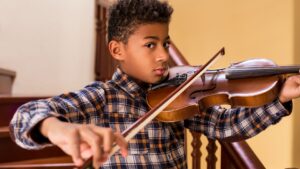As music teachers who specialize in private instruction for beginner students, we know firsthand that no two learners are exactly alike. One of the most common questions we’re asked is whether violin lessons for adults should be different from those for children—and the answer is a resounding yes! While both age groups can absolutely thrive on the violin, their motivations, attention spans, physical development, and learning styles vary. That’s why successful lessons are always tailored to the student in front of us.
Key Differences Between Adult and Child Learners
Understanding the contrast between adult and child violin learners helps set realistic expectations and design an engaging lesson plan. Here’s what we’ve observed across hundreds of students:
1. Motivation
- Adults often choose violin lessons for personal fulfillment, stress relief, or a lifelong dream.
- Children are usually enrolled by a parent and may need more help connecting with the “why” behind practicing.
2. Learning Style
- Adults prefer understanding the theory, structure, and purpose behind techniques.
- Kids respond well to games, repetition, and creative exploration.
3. Physical Ability
- Children may struggle with posture or holding the violin, especially younger ones.
- Adults typically have better fine motor skills, but may face tension or physical limitations.
4. Time & Practice Habits
- Kids often benefit from routine and parent-guided practice.
- Adults may need flexible plans to accommodate work, family, or other responsibilities.
Customizing Violin Lessons to Fit Every Student
We approach violin lessons for adults and children with different tools but the same goal: to create an encouraging, effective learning environment. Here’s how we tailor our teaching:
- For children:
- Use visual aids, rhythm games, and fun songs
- Emphasize short, frequent practice sessions
- Incorporate movement to keep focus and energy high
- For adults:
- Focus on technique, posture, and tone quality
- Allow time for questions and deeper understanding
- Adjust pacing based on personal goals
Learning the Violin at Any Age
Whether you’re 6 or 60, it’s never too late (or too early) to start learning violin. The key is finding a teacher who understands how to adapt their approach. That’s the heart of private, in-home lessons—personalized guidance every step of the way. If you’re an adult looking to get started, check out our blog on what to expect in beginning violin lessons.
Looking for research-backed insights? The American String Teachers Association offers excellent resources on music learning across all age groups.
FAQ: Adult vs. Child Violin Lessons
Can adults really learn violin as beginners?
Absolutely! With consistency and the right instruction, adult beginners often progress quickly due to their focus and dedication.
How long should children practice violin each day?
For young beginners, 15–20 minutes a day is a great start. The key is routine, not duration.
Do adults need a different violin size than children?
Yes. Adults typically use a full-size violin, while children may need smaller instruments depending on their age and arm length.
